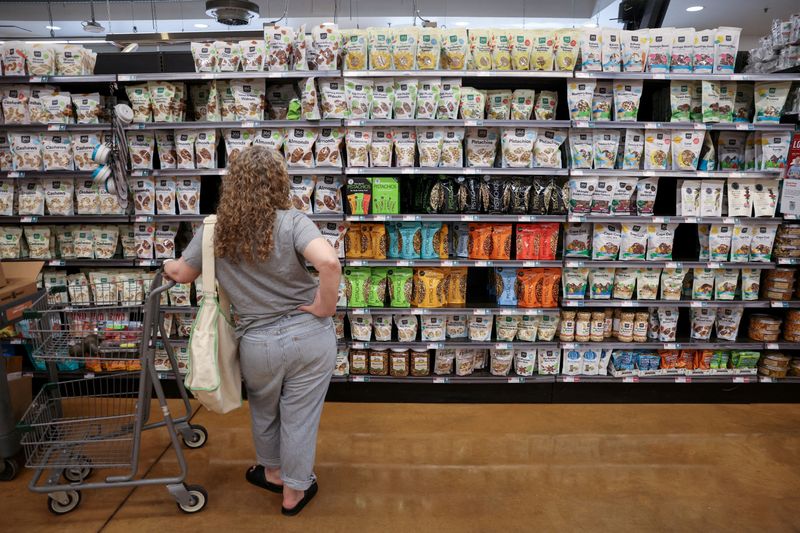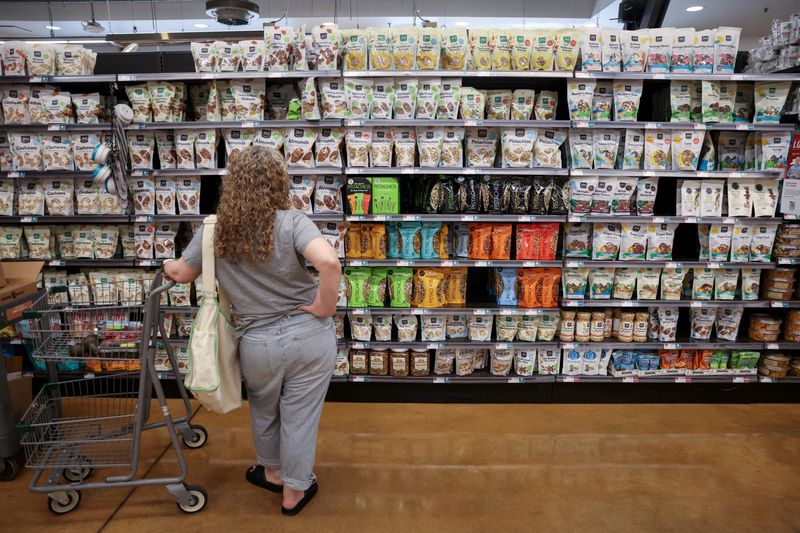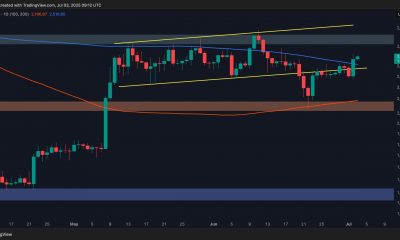Economy
Analysis-Global banks see no recession, US companies are more circumspect


© Reuters. A person shops in a supermarket in Manhattan, New York City, U.S., June 10, 2022. REUTERS/Andrew Kelly/File Photo
2/2
By Vidya Ranganathan and Gaurav Dogra
SINGAPORE (Reuters) – Heading into 2024, analysts say the U.S. recession they’d been forecasting for two years isn’t coming anymore. Everyone else, from companies to investors, is still bracing for a slowdown caused by tepid consumer demand.
Dissonance between the habitually bullish investment bank analysts and the more circumspect money managers is not new. What’s different this time is the level of prudence and caution from some top companies as they outline their plans for next year.
Real money managers are in no doubt about which side to trust. After months of being wrong footed, sell-side analysts are a bit too bullish about growth prospects, Fed rate cuts and a consumption recovery, they say.
“Take a grain of salt maybe to measuring the efficacy of some of these sell-side forecasts,” says Patrick McDonough, a portfolio manager for PGIM Quantitative Solutions. “I would be a little bit more on the side of the companies.
Consensus forecasts from major banks, including Goldman Sachs, Morgan Stanley, UBS and Barclays, are for global growth to be constrained in 2024 by elevated interest rates, pricier oil and a weakened China, but with low odds for a recession. A year ago, many banks were forecasting a U.S. recession.
Businesses are sounding more grim than they did last year.
In its collection of management commentary from 150 earnings calls in the third-quarter reporting season, Deutsche Bank last month said companies broadly characterized demand as being somewhat weak, but not alarmingly so. Companies have continued to cut inventories as they adjust to sluggish demand for goods.
The words used by companies to describe demand included soft, sluggish, slow, lackluster, choppy, muted, constrained, challenging, weak, pressured and uneven, Deutsche said.
Retailer Walmart (NYSE:) said earlier this month that while it has been surprised by the resilience of the consumer this year in the face of rising prices, that behaviour was changing and it was turning cautious.
Walmart’s chief financial officer John David Rainey told a Morgan Stanley consumer and retail conference earlier this month the firm wasn’t trying to ring an alarm bell, but that caution was “certainly a departure from what we saw in the first three quarters of the year”.
In its latest earnings transcript, discount chain Dollar General (NYSE:) said gross profit was down, interest expenses had climbed and that it anticipated “customer spending may continue to be constrained as we head into 2024, especially in discretionary categories.”
Consumer giant Procter & Gamble (NYSE:) sounded a more optimistic note. Andre Schulten, the company’s chief financial officer, recently said P&G was able to grow its share of volume and value in U.S. markets in the latest quarter, noting the “consumer remains strong.
The disconnect does not perturb fund managers. What matters to them however is whether the Federal Reserve manages to avert recession and yet contain inflation, without hurting consumers.
After leaving markets guessing for months, the Fed’s most recent update shows it recognizes that need for balance and that officials are sensitive to the risks of over-tightening policy and pushing the economy into a faster than necessary slowdown.
Several companies are already feeling the slowdown.
“The consumer is starting to slow down a little bit and the consumer-based companies, which really are almost all the big companies at this point, are starting to talk about that,” said PGIM’s McDonough. The global asset manager has $1.27 trillion in assets.
Consumer spending has indeed been cooling, as per surveys from the Institute for Supply Management (ISM). A November survey from the Conference Board showed about two-thirds of consumers still perceived a recession to be “somewhat” or “very likely” to happen over the next year.
RECESSION IS COMING?
The past two years haven’t been easy for macro pundits trying to reconcile the drivers of a post-pandemic bounce and trillions of dollars worth of stimulus in global markets alongside hawkish central banks.
Indicators from manufacturing surveys to an inverted U.S. yield curve and a bumper fiscal spending plan all screamed slowdown, or even recession.
Reuters polls conducted through 2022 and until mid-2023 consistently showed economists’ median probability for a U.S. recession within a year were above 60%. That probability is now closer to 45%.
“To be fair, it’s been a difficult year,” said Chris Rands, a senior portfolio manager with the global multi-asset team at Nikko Asset Management.
“If you were to go back and look historically, if you use U.S. lead indicators, for example, they’ve been telling you that the U.S. should have entered a recession 12 months ago.”
“But if you’ve been able to make that argument for 12 months, you’ve potentially got egg on your face.”
Big banks forecast the global economy slowing in 2023, with a likely U.S. recession. Even the most bullish forecasts had the rising about 9% in 2023. It has rallied 21% so far.
In 2022, sell-side analysts from major banks expected growth to stumble but for stocks to keep rising. The S&P 500 fell 19% that year.
Forecasts for 2024 are more conservative, and laced with caveats. Even the most bullish Street forecasts for US stocks are for single-digit gains.
“Companies talk to their bankers and to economists and consultants, and so on. And so they are all getting the same picture, which is there’s going to be a slowdown,” said Deutsche Bank’s Thatte.
“They are biding their time and being cautious which makes sense. And so if growth picks up, they will respond accordingly.”
Economy
Russian central bank says it needs months to make sure CPI falling before rate cuts -RBC


© Reuters. Russian Central Bank Governor Elvira Nabiullina attends a news conference in Moscow, Russia June 14, 2019. REUTERS/Shamil Zhumatov/File Photo
MOSCOW (Reuters) – Russia’s central bank will need two to three months to make sure that inflation is steadily declining before taking any decision on interest rate cuts, the bank’s governor Elvira Nabiullina told RBC media on Sunday.
The central bank raised its key interest rate by 100 basis points to 16% earlier in December, hiking for the fifth consecutive meeting in response to stubborn inflation, and suggested that its tightening cycle was nearly over.
Nabiullina said it was not yet clear when exactly the regulator would start cutting rates, however.
“We really need to make sure that inflation is steadily decreasing, that these are not one-off factors that can affect the rate of price growth in a particular month,” she said.
Nabiullina said the bank was taking into account a wide range of indicators but primarily those that “characterize the stability of inflation”.
“This will take two or three months or more – it depends on how much the wide range of indicators that characterize sustainable inflation declines,” she said.
The bank will next convene to set its benchmark rate on Feb. 16.
The governor also said the bank should have started monetary policy tightening earlier than in July, when it embarked on the rate-hiking cycle.
Economy
China identifies second set of projects in $140 billion spending plan


© Reuters. FILE PHOTO: Workers walk past an under-construction area with completed office towers in the background, in Shenzhen’s Qianhai new district, Guangdong province, China August 25, 2023. REUTERS/David Kirton/File Photo
SHANGHAI (Reuters) – China’s top planning body said on Saturday it had identified a second batch of public investment projects, including flood control and disaster relief programmes, under a bond issuance and investment plan announced in October to boost the economy.
With the latest tranche, China has now earmarked more than 800 billion yuan of its 1 trillion yuan ($140 billion) in additional government bond issuance in the fourth quarter, as it focuses on fiscal steps to shore up the flagging economy.
The National Development and Reform Commission (NDRC) said in a statement on Saturday it had identified 9,600 projects with planned investment of more than 560 billion yuan.
China’s economy, the world’s second largest, is struggling to regain its footing post-COVID-19 as policymakers grapple with tepid consumer demand, weak exports, falling foreign investment and a deepening real estate crisis.
The 1 trillion yuan in additional bond issuance will widen China’s 2023 budget deficit ratio to around 3.8 percent from 3 percent, the state-run Xinhua news agency has said.
“Construction of the projects will improve China’s flood control system, emergency response mechanism and disaster relief capabilities, and better protect people’s lives and property, so it is very significant,” the NDRC said.
The agency said it will coordinate with other government bodies to make sure that funds are allocated speedily for investment and that high standards of quality are maintained in project construction.
($1 = 7.1315 renminbi)
Economy
Russian central bank says it needs months to make sure CPI falling before rate cuts -RBC


© Reuters. Russian Central Bank Governor Elvira Nabiullina attends a news conference in Moscow, Russia June 14, 2019. REUTERS/Shamil Zhumatov/File Photo
MOSCOW (Reuters) – Russia’s central bank will need two to three months to make sure that inflation is steadily declining before taking any decision on interest rate cuts, the bank’s governor Elvira Nabiullina told RBC media on Sunday.
The central bank raised its key interest rate by 100 basis points to 16% earlier in December, hiking for the fifth consecutive meeting in response to stubborn inflation, and suggested that its tightening cycle was nearly over.
Nabiullina said it was not yet clear when exactly the regulator would start cutting rates, however.
“We really need to make sure that inflation is steadily decreasing, that these are not one-off factors that can affect the rate of price growth in a particular month,” she said.
Nabiullina said the bank was taking into account a wide range of indicators but primarily those that “characterize the stability of inflation”.
“This will take two or three months or more – it depends on how much the wide range of indicators that characterize sustainable inflation declines,” she said.
The bank will next convene to set its benchmark rate on Feb. 16.
The governor also said the bank should have started monetary policy tightening earlier than in July, when it embarked on the rate-hiking cycle.

 Forex3 years ago
Forex3 years agoForex Today: the dollar is gaining strength amid gloomy sentiment at the start of the Fed’s week

 Forex3 years ago
Forex3 years agoUnbiased review of Pocket Option broker

 Forex3 years ago
Forex3 years agoDollar to pound sterling exchange rate today: Pound plummeted to its lowest since 1985

 Forex3 years ago
Forex3 years agoHow is the Australian dollar doing today?

 Cryptocurrency3 years ago
Cryptocurrency3 years agoWhat happened in the crypto market – current events today

 World3 years ago
World3 years agoWhy are modern video games an art form?

 Commodities3 years ago
Commodities3 years agoCopper continues to fall in price on expectations of lower demand in China

 Economy3 years ago
Economy3 years agoCrude oil tankers double in price due to EU anti-Russian sanctions





























